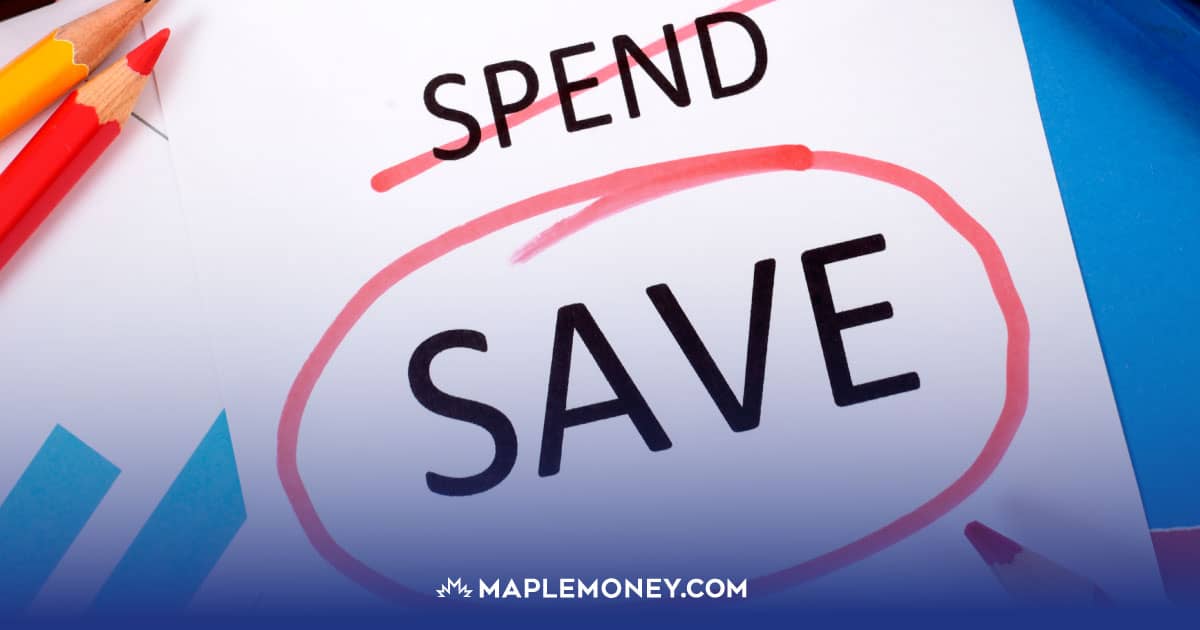How to Save for a Down Payment: 12 Simple Tips for Canadians

Saving for a down payment can seem like a daunting and overwhelming task, especially for first-time homebuyers. However, with the right financial moves and a clear plan in place, you can make strides toward achieving your goal of purchasing a home.
To help, we’re providing you with several practical tips and strategies so you can start saving for a down payment, and get closer to owning your first home.
How to Save for a Down Payment
The following tips can help you on your journey to saving money for a home purchase. While you may not want or need to implement every idea on our list, the more things you can try, the faster you’ll reach your down payment goal.
1. Cut Your Expenses
If you’re struggling to set aside enough money to save for a down payment, there’s a good chance cash flow is an issue. There are a couple of ways to fix it. You can cut your spending to free up more money, increase your income, or do a little of both.
The easiest place to start is to cut expenses. Take a close look at your spending habits and identify areas where you can cut back. This might include dining out, entertainment, or even your cellphone plan. Every dollar saved adds up and gets you closer to your down payment goal.
2. Pay off High-Interest Debt
If you have high-interest debt in the form of credit card balances or retail store financing, the interest charges are eating into your ability to save. Most credit cards charge at least 20% APR if you’re not paying off the balance in full each month. The interest rates are much higher than anything you would earn in a savings account or investment. If you prioritize paying off your high-interest debt, you’ll find it easier to save money in the long run.
3. Create a Budget
If you want to accomplish any big goal in life, it helps to have a plan. A budget is a plan for your money. By creating and sticking to a budget, you can monitor your expenses and stay on track as you save for a down payment. There are many different ways to budget. A 50/30/20 budget is easy to follow, or you can try a zero-based budget, which is a little more strategic.
4. Automate Your Savings
You’ll have more success if you automate your down payment savings. To do this, set up an automatic transfer from your chequing account to a separate savings account every payday. This will help you save without having to remind yourself constantly.
5. Consider Selling Your Second Car
You’ve probably heard the saying, “cars are a money pit.” And it really is true. Whether you drive a new vehicle with big payments or an old one that requires regular maintenance, every vehicle you own is an additional expense. While having a second car can be very convenient, you’ll free up a lot of extra cash flow by selling it.
6. Save Your Work Bonuses
A lot of people get bonuses at work once or twice a year. While it can be tempting to treat yourself with a bonus by taking a trip or splurging on a big ticket purchase, you can save for a house more quickly by directing your work bonuses to your down payment savings.
7. Save Your Income Tax Refund
Another lump sum many Canadians receive yearly is an income tax refund. Treat your tax refunds as an unexpected bonus and add them to your down payment savings.
8. Save Money in a TFSA
When you start saving money, you must decide what type of account to put your money into. There are many different options, and using multiple accounts when saving for a down payment is a good idea, as each type has its advantages.
One of the first accounts you should open is a Tax-Free Savings Account (TFSA). A TFSA allows your savings to grow tax-free, giving you more money for your down payment. You can invest your TFSA funds in a number of ways: cash, GICs, mutual funds, ETFs, stocks and bonds, etc. Just make sure your investment aligns with your time frame and risk tolerance, and be careful not to exceed your available contribution room.
9. Save Money In an FHSA
In 2023, the Canadian government launched the First Home Savings Account (FHSA). The account is designed to help first-time homebuyers save for a down payment. It offers a number of benefits and should be one of the first places you put your down payment savings.
The annual contribution limit is $8000, up to a lifetime limit of $40,000. Like an RRSP, your contributions are tax-deductible. However, you aren’t subject to income tax when you withdraw money to purchase a qualifying home. Also, you don’t have to repay the money back into the FHSA, like you do under the Home Buyers Plan (HBP).
10. Take Advantage of the Home Buyers Plan (HBP)
If you’ve maximized your FHSA contributions, remember that you can borrow tax-free money from your RRSP to purchase your first home under the Home Buyer’s Plan (HBP). This program has been around for years and is still an effective way to save for a down payment.
Remember that you need to repay the money back into the RRSP over a 15-year period, or you will face penalties. If you have room in your FHSA, you can transfer money from your RRSP into your FHSA without any tax implications.
11. Save Money in a High-Interest Savings Account
If you plan to purchase a home in 3 years or less, you won’t want to invest your down payment savings in market-based investments, as they can and will fluctuate in value, and you could lose your money.
Instead, consider opening a high-interest savings account. HISAs earn more interest than regular savings accounts and can help your down payment money grow faster. You can open a high-interest savings account inside a TFSA.
12. Start a Side Hustle
At the outset of this list, I mentioned that there were two ways to improve cash flow – reduce your expenses or increase your income. One of the best ways to do the latter is by starting a side hustle to make extra money. You can direct the funds towards paying off high-interest debt or saving for your down payment. If you need side hustle ideas, check out this list of 18 proven ways to make $100 in a day.
Final Thoughts
Saving money to buy a house takes dedication and discipline. Remember the importance of tackling high-interest debts first, as this can save you money in the long run and make it easier to focus on accumulating the down payment.
Remember to prioritize your financial goals based on your current situation and future plans and do your best to stay committed to your savings plan no matter what happens.
Know that sacrifices may be necessary, but remember that the long-term benefits of owning a property can be worth the effort.
FAQs
What percentage of my income should I save for a down payment?
It’s generally recommended to save at least 20% of your income for a down payment, but this percentage may vary depending on your individual financial situation and the housing market in your area.
It’s important to consider your other financial obligations, such as existing debts, emergency funds, and monthly expenses. Evaluating these factors will help you determine how much you can comfortably set aside for a down payment without compromising your financial stability.
How can I save for a down payment while on a low income?
Saving for a down payment on a low income can be challenging, but it’s not impossible. I recommend that you automate your savings to make saving for a down payment part of your regular financial routine. Don’t be discouraged if you can only set aside a small amount at first. As your cash flow improves, you’ll be able to increase your savings amount.
If you can, look for ways to increase your income. Consider using side hustles to make extra money and earmark those funds specifically for your down payment savings.
While saving for a down payment on a low income might take longer, persistence and careful budgeting can help you reach your goal.
What is the recommended down payment percentage for buying a home?
The recommended down payment percentage is typically 20% of the purchase price. Providing a 20% down payment allows you to avoid mortgage default insurance and reduce your monthly mortgage payments.
For many first-time homebuyers, a 20% down payment might not be feasible. In this case, a minimum down payment of 5% is an option for homes priced under $500,000 and 10% for the portion above $500,000.
However, the larger your down payment, the lower your monthly mortgage payments will be, so saving as much as possible is always helpful.


